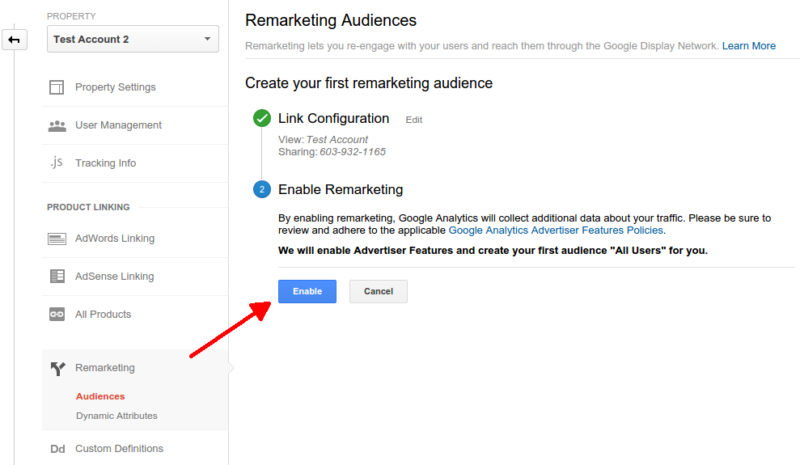Enhancing Your Campaigns with Remarketing In Google Analytics
Enhancing Your Campaigns with Remarketing In Google Analytics
Blog Article
Optimize Your ROI With Remarketing in Google Analytics
In the realm of digital marketing, the utilization of remarketing techniques within Google Analytics has shown to be a potent device for enhancing return on financial investment. By harnessing the power of customer information and tailoring advertisements to details target market sections, businesses can dramatically enhance their conversion rates. The genuine vital lies in the art of precision - understanding individual habits, crafting compelling ads, and continuously refining techniques to drive optimal results. The trip to maximizing ROI via remarketing is a nuanced path led with insights and opportunities that can improve the trajectory of your advertising ventures.
Comprehending Remarketing in Google Analytics
Comprehending remarketing in Google Analytics is crucial for maximizing your digital advertising and marketing method. Remarketing permits you to target customers that have actually formerly seen your web site or engaged with your application, providing them with tailored ads as they browse various other sites or make use of various other applications within the Google Present Network. This approach helps keep your brand name top of mind and encourages individuals to return to your website, ultimately raising the probability of conversion.
By utilizing Google Analytics, you can track the performance of your remarketing campaigns, acquiring beneficial understandings right into user habits, involvement, and conversions. This data enables you to improve your bidding process, targeting, and messaging techniques to improve the total performance of your projects.
Furthermore, understanding the various kinds of remarketing listings offered in Google Analytics, such as typical, dynamic, and comparable target markets, allows you to create very segmented and individualized projects customized to particular customer sections. This level of granularity can significantly boost the significance and effect of your remarketing initiatives, ultimately optimizing your roi.
Setting Up Remarketing Checklists
To successfully carry out remarketing projects in Google Analytics, the preliminary action includes configuring and producing remarketing lists targeting specific customer sections based upon their communications with your internet site or app. By establishing up remarketing listings, you can customize your advertising initiatives to reach customers who have actually currently shown rate of interest in your product and services.
To begin, browse to the Admin area of your Google Analytics account and choose the Building where you wish to create the remarketing list. Then, under the Residential property column, click 'Target market Definitions' and choose 'Target markets.' Next, click on the red 'New Audience' button and select 'Produce New' to specify the parameters for your remarketing list.

Crafting Efficient Remarketing Ads
When crafting your ads, focus on creating attention-grabbing headings and compelling visuals that stand out to prospective clients. Include solid calls-to-action that urge users to revisit your website and finish a wanted activity. Use dynamic remarketing to show individualized ads featuring product and services that users have actually previously seen on your site.
Additionally, ensure that your ads are mobile-friendly since a significant portion of net web traffic originates from mobile gadgets. Test different advertisement variants to identify which messages and layouts drive the finest results. By continuously refining and optimizing your remarketing ads based upon efficiency data, you can optimize their performance and boost your roi.
Studying Remarketing Performance

Via Google Analytics, marketing experts can track the performance of their remarketing projects in real-time, enabling them to recognize patterns, patterns, and locations for enhancement promptly. By assessing the data, marketing experts can identify which advertisements are performing well, which target market segments are reacting positively, and which channels are driving one of the most conversions. This degree of granularity allows marketing experts to make data-driven decisions to maximize their remarketing advocate much better outcomes.
Optimizing ROI With Remarketing
Examining remarketing data in Google Analytics enables marketing professionals to determine opportunities for enhancing roi (ROI) through calculated changes - What Is “Remarketing” In Google Analytics?. To make best use of ROI with remarketing, it is essential to recognize the actions of your audience. By evaluating user communications, such as the web pages they visited, the products they checked out, or the activities they tackled your website, you can tailor your remarketing projects extra efficiently
Segmenting your target market based upon their actions permits you to create personalized and targeted ads that are most likely to resonate with them. By revealing pertinent advertisements to specific segments of your audience, you can raise the chances of conversion and eventually boost your ROI.
Furthermore, testing different ad creatives, messaging, and offers can aid recognize what reverberates ideal with your target market. A/B screening that site enables you to explore various aspects of your ads to determine what drives the highest engagement and conversion rates.
Verdict
Finally, making best use of ROI with remarketing in Google Analytics requires a calculated method to evaluating user behavior, segmenting target markets, developing tailored advertisements, and enhancing campaign performance. By leveraging data-driven understandings and testing different strategies, businesses can boost their remarketing initiatives to drive higher engagement and conversion prices. This organized method makes certain that resources are successfully designated towards taking full advantage of returns on financial investment in remarketing campaigns.
Next off, click on the red 'New Target market' button and pick 'Create New' to specify the criteria for your remarketing checklist.
By constantly refining and optimizing your remarketing advertisements based on performance information, you can maximize their performance and improve your return on financial investment.
By delving right into these insights, online marketers can gain a thorough understanding of exactly how their remarketing efforts are reverberating with their target audience and driving conversions. To take full advantage of ROI with remarketing, it is crucial to comprehend the behavior of your target market.In final thought, making best use of ROI with remarketing in Google Analytics calls for a tactical approach to assessing individual actions, segmenting target markets, producing customized ads, and maximizing project efficiency.
Report this page